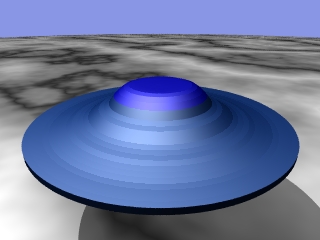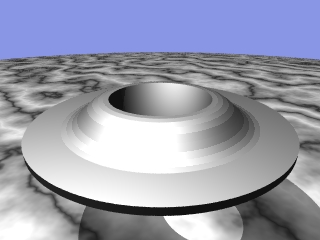Welcome to the GARAGe flywheel demo page

This page reviews work done by the Genetic Algorithms Research and Application Group (the GARAGe) on the design of composite material flywheels. The GARAGe is a multidisciplinary group interested in both the application and theoretical development of genetic algorithms and related evolutionary programming techinques. It is jointly run by Bill Punch and Erik Goodman at Michigan State University, either of home you can email by selecting their names above. Please visit the GARAGe home page for more information. The flywheel animations can be found at the end of this page.
What is a flywheel?A flywheel is simply a heavy wheel, usually composed of metal. It may be any shape, from disk to saucer, and is typically symetric. The most useful property of a flywheel is usually considered to be its mass. |

A racing car flywheel. Photo courtesy Turner Morotsport. |
||||
What is a flywheel used for?
There are at least two mechanical purposes for flywheels. The most common is moderating speed fluctuations in an engine through its inertia. This is precisely the purpose for the flywheel you might find in an everyday single cylinder gas engine, such as a push power lawn mower. Since the flywheel is heavy, quick spurts by the engine or sudden loads (such as hitting a clump of weeds) are evened out.
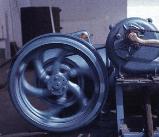
A mechanical flywheel on a water pump.
Photo courtesy Stirling Technology
A second use for flywheels is much more interesting to researchers in modern energy storage technology. When we spin a flywheel, we invest a certain amount of energy which increases the momentum of the flywheel. Some of this energy is lost over time to friction; however, if we hold the flywheel in a relatively friction free environment (say by suspending it in a magnetic field in a vaccum), then it is able to store the energy we used to spin it in the form of kinetic energy. Later, we may be able to retreive this energy either through direct mechanical, or electrical translation. For example, we may fix magnets to the flywheel and be able to use it as the core for an electrical generator. Of course, as we take away energy (in the form of electricity), the flywheel slows down; so we haven't gained anything, but we have managed to store the power in the flywheel for a while.

Prototype electro-mechanical battery from
Larwence Livermore National Labs.
Photo courtesy Larwence Livermore National Laboratories.<
Why store energy in a flywheel?
Flywheel batteries have the potential of storing much more energy per unit of mass than standard chemical batteries. This is very important in situations where we need maximize energy storage in the smallest available mass. A good example of such a situation is a self-contained electric powered vehicle. For more information on flywheels and other storage alternatives for electric vehicles, check out the Department of Energy's Hybrid Electric Vehicle web site.
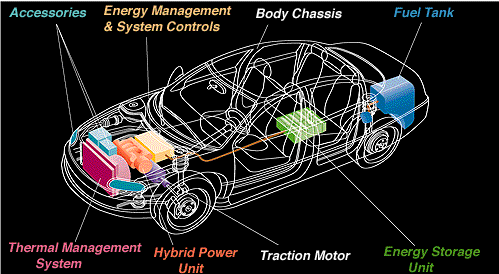
Diagram of a Hybrid Electric Vehicle.
Photo courtesy Department of Energy.
What are composite materials?
Composite materials are a new class of materials that combine two or more separate components into a form suitable for structural applications. While each component retains its identity, the new composite material displays macroscopic properties superior to its parent constituents, particularly in terms of mechanical properties and economic value. In particular, composite materials may use any number of materials and construction techniques, from basic metalurgy to ceramic, polymer/co-polymer, and carbon fiber construction techniques. Refer to the Michigan State University Composite Materials and Structures Center for more information on composite materials research.
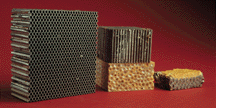
Several composite blocks.
Photo courtesy University of Delaware.
Why make composite flywheels?
The faster we can spin a flywheel and the more massive we can make it, the flywheel, the more kinetic energy we can store in it. However, at extreme speeds, even metal flywheels can literally tear themselves apart from the shear forces which are generated. Further, the energy storage characteristics of the flywheel are influenced more strongly by its maximal rotational velocity than by its mass. So a stronger, lighter flywheel may be able to store as much or more energy than its metalic counterpart.
What is a genetic algorithm?
A genetic algorithm is an approach to solving problems which are not yet fully characterized or too complex to allow full characterization, but for which some analytical evaluation is available. That is, problems for which we don't necessarily know how to make a good solution, but we can evaluate by some quantifiable measure the relative value of a solution (or at least the relative value of one potential solution in comparison to another).
The basic concept of a genetic algorithm is to encode a potential solution to a problem as a series of parameters. A single set of parameter values is treated as the genome or genetic material of an individual solution. A large population of candidate solutions are created (initially with random parmeter values). These solutions are essentially bred with each other for several simulated generations under the principle of survival of the fittest, meaning that the probability that an individual solution will pass on some of its parameter values to subsequent children is directly related to the fitness of individual (i.e. how good that solution is relative to the others in the population).
Breeding takes place through use of operators such as crossover which simulates basic biological cross-fertilization, and mutation (essentially the introduction of noise). The simple application of these operators with a reasonable selection mechanism has produced startlingly good results over a wide range of problems.
Why use a genetic algorithm for flywheel design?
The problem is that while researchers have a reasonable idea how to design and analyze an isometric (single material) flywheel, there are no closed formulas yet to help us select the composition and shape of composite flywheels. Current research does allow us to approximate the analysis of composite flywheel design. Such a situation, where we have an method of analytical feedback, but no direct formula for design is perfectly suited to an evolutionary computation method such as a genetic algorithm.
How do you use a GA in flywheel design?The experiments we are reporting on here use allow the GA to choose the material for each of several slices, or rings, of the flywheel. Also the GA chooses the shape of the flywheel by choosing the height of the flywheel at the interface between each two rings. The these parameters are evaluated using specialized finite element analysis code developed here at MSU. Since the flywheel is symetric, we only need to view a single 2D slice of the flywheel to see its shape. For exapmle, the following 2D and 3D pictures illustrate the same flywheel.
 2D slice view of a composite flywheel |
 3D view of a composite flywheel |
To help visualize the evolution of a design during a typical GA run, the following movies illustrate the succesive best so far designs located during a single run. The colored bands represent different composite material selections. It is important to emphasize that the GA itself has no knowledge about what a good flywheel should look like, other than the feedback given by the evaluation code; nonetheless, strikingly symetrical designs develop.
To view the animations, you can download a quicktime viewer from Apple . You can get xanim if you are using unix.
